
Nucs: making, managing, using. A talk and hands-on demo to improve your beekeeping skills.
John Badley and Nick Silver take you through the selection of nucleus hives you are likely to see in this part of the world, followed by an appreciation of the basic considerations when making up a nuc colony.
This will be followed by a description of the nuc making process plus some variations on this theme.
Finally the participants will put nucs together under the watchful eye of the tutors. There will be time for questions, as well as tea and cakes!
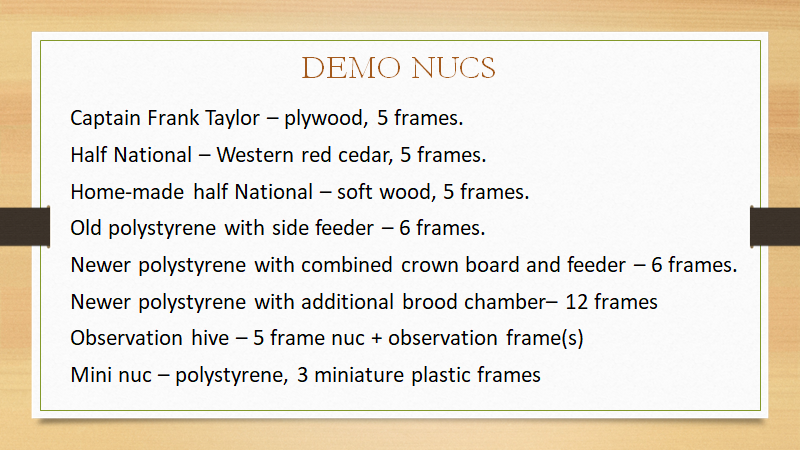
These eight types of nuc represent both old and new designs. The Taylor nuc is mentioned as Frank Taylor lived in the area and there may still be some of these to be found second hand. They are small, light and handy for catching swarms but not recommended for overwintering colonies as the plywood is thin.
The western red cedar National nuc is the standard 5 frame hive sold by most bee equipment suppliers. The home-made soft wood version would be a fraction of the cost and is easy to make.
The old-style poly nuc had a feeder trough on one side and was prone to drowning bees.
The newer poly nucs have a combined crown board and feeder which is more versatile. They can also be supplied with additional brood boxes. Nick explained the various scenarios for overwintering nucs in these hives.
5 frame nucs used as an observation hive offer a good way to demonstrate bees to the public. It is essential to consider health and safety measures for the public and survival issues for the bees.
The 3 frame mini nuc has been included to emphasise the small number of bees in this type of hive. Less experienced beekeepers are recommended to use the larger 5 and 6 frame nucs which have far fewer problems with starving, absconding and over crowding.
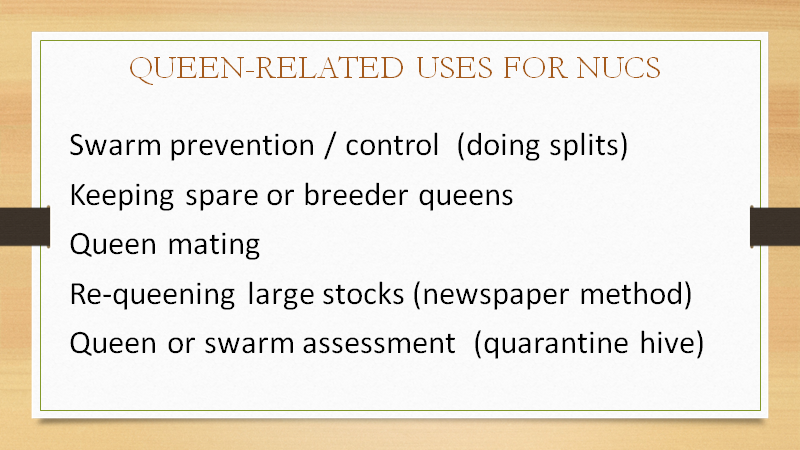
The five uses for nucs listed above are all queen-related. Comments are: breeder queens will survive longer in a nucleus colony as opposed to a full hive; queen mating requires a hopelessly queenless colony into which the new queen cells are placed; re-queening large stocks – see later; quarentine hives/apiaries should be considered for all swarms and hives that are moved from one area to another.
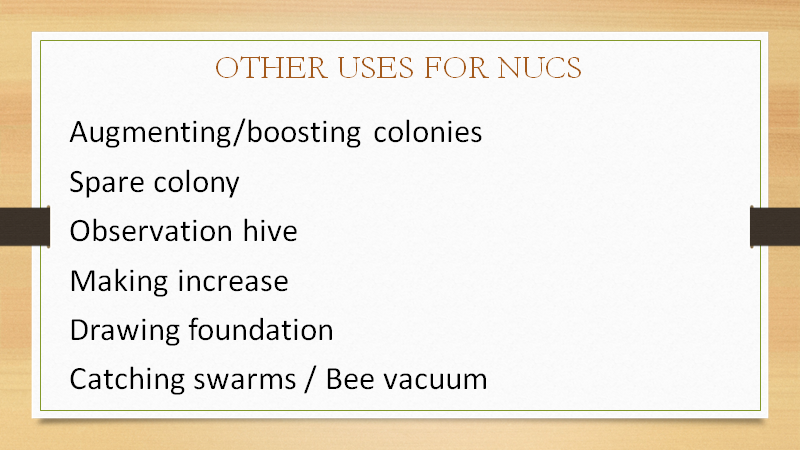
Other uses for nucs are listed on the slide and are largely self explanatory.
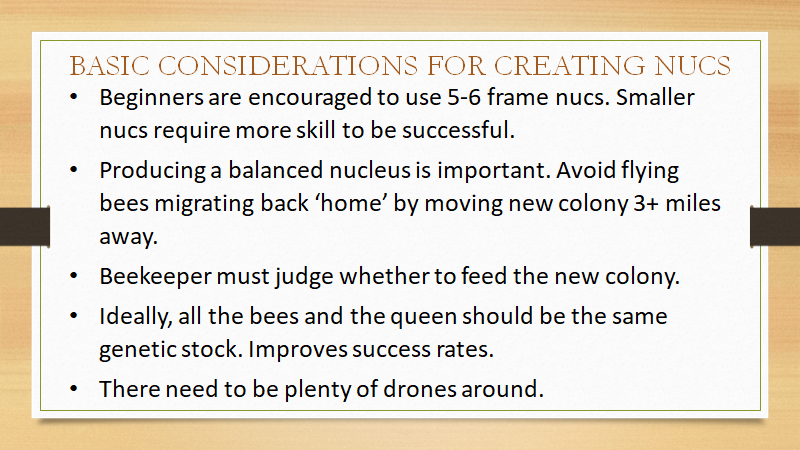
When making up nucs, the importance of a balanced colony cannot be over stressed. Allowing flying bees to migrate back to the donor hive leaves the nuc with no foragers, causing a dearth of fresh pollen and nectar when most needed. The imbalance will be corrected eventually but the delay slows down the development of the nucleus colony.
Don’t start colony manipulations too early in the year. There need to be plenty of drones around for successful mating.
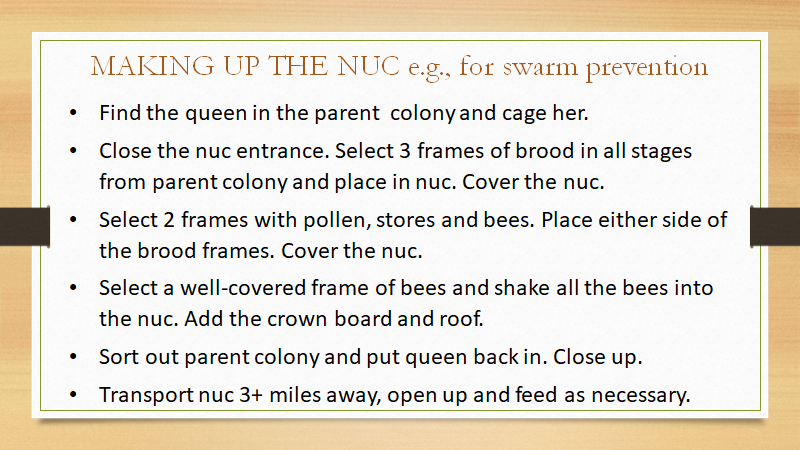
This method can be used for proactive swarm prevention but there are many variations to suit your needs. You require a well stocked parent colony, a nuc box and spare frames of foundation. This is what you will be doing in the apiary.
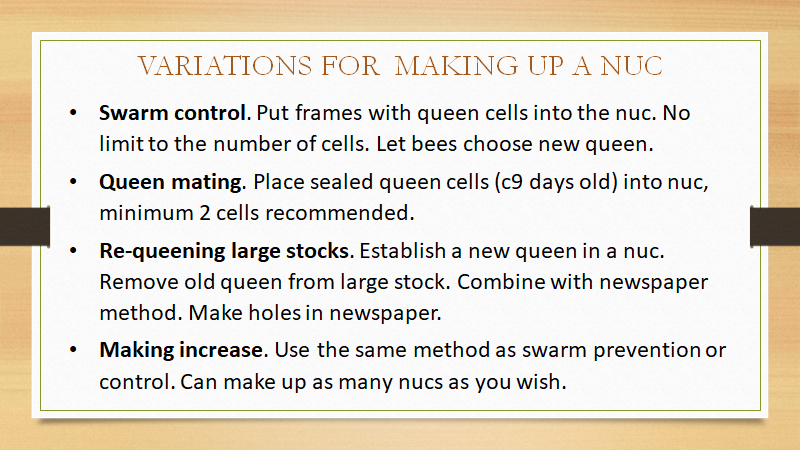
Instead of swarm prevention you may need to use a nuc for swarm control, in which case put frames with queen cells into the nuc and remove queen cells from the donor colony.
Queen mating requires the nuc to be unable to produce new queen cells so make sure brood is sealed. Then you can add the new queen cells from your cell raising colony. The day 9 recommendation means they are less likely to be damaged during transfer.
It is often difficult to re-queen large or aggressive stocks. This method surrounds the new queen with her own kind who will protect her from aggression until her pheromones are spread around the colony.
Making increase is like swarm prevention or swarm control but you can make up as many nucs as you like.
Discussion
When using nucs for swarm prevention, do you put the old queen back into the original hive or into the nuc? Some people say that putting the old queen into the nuc and moving it away 3+ miles is the nearest you will get to emulating a natural swarm. You choose.
To summarise, nucs are an essential part of a beekeeper’s kit. They can be used for numerous purposes in a variety of ways to make your beekeeping easier and more productive.